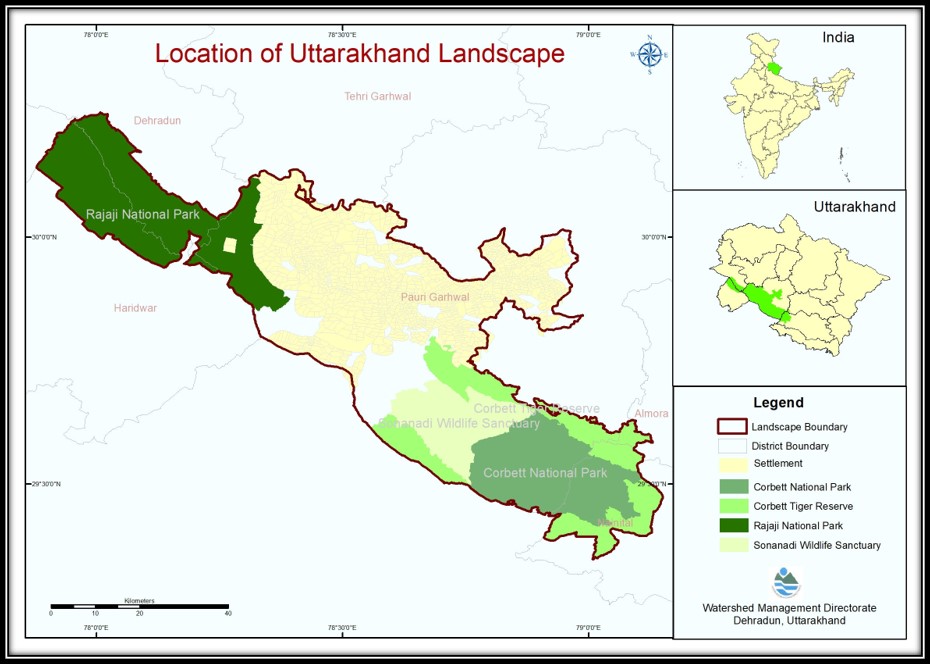"Green-Ag : Transforming Indian Agriculture for Global Environmental Benefits and the Conservation of Critical Biodiversity and Forest Landscapes"
The Agriculture sector has made immense progress in contributing to the country’s food security. India is one of the largest exporters of agricultural produce. Over the years, the contribution of agriculture to the GDP has diminished considerably. However, it continues to be the largest source of livelihood in India. The Government of India (GoI) invests significantly to boost agricultural production by promoting modern intensive agricultural practices, which has facilitated the country to make great strides in production and productivity, thus emerging as a net exporter of food grains. However, the current farming practices are proving to be increasingly unsustainable due to resource intensive practices mostly dependent on external inputs. Consequently, there is a growing pressure on the ecology, especially, critical habitats and Protected Areas of high biodiversity importance along with pronounced negative impacts on natural resources like land, soil, and water, particularly groundwater aquifers. On the other hand, the GoI and other partners invest significantly in Protected Area management to support and conserve a host of globally significant species. Thus, these different streams of Government’s investments are often misaligned and incompatible with each other leading to agricultural and environmental activities acting at cross-purposes, resulting in net economic loss to the country and wasted financing. The agriculture sector in the country is critically poised to address issues of its long-term sustainability. This requires the sector to fully integrate environmental concerns in its policies, plans and programmes, so as to ensure that the sector’s negative environmental impacts are mitigated and positive contributions are enhanced. Therefore, environmental mainstreaming is of key importance, especially in the context of the changing climate. The Green-Ag Project aims to catalyze the sustainable transformation of India’s agriculture, without compromising the country’s food security and farmers’ income. The project seeks to mainstream biodiversity conservation, climate change, and sustainable land management objectives and practices into Indian agriculture to enhance multiple global environment benefits. The project supports harmonization between India’s agricultural and environmental sector priorities and investments so that the achievement of National and GEBs can be fully realized without compromising India’s ability to strengthen rural livelihoods and meet its food and nutrition security requirements. The project also aims to bring greater coherence between the Government’s policies, investments and institutions concerned with conservation and agricultural production at landscape level, so that they become mutually compatible. The Green-Ag Project is funded by the Global Environment Facility (GEF) through its sixth funding cycle. The Department of Agriculture and Farmers Welfare (DA&FW) is the National Executing Agency and FAO is the Implementing Agency. The Ministry of Environment, Forest and Climate Change (MoEF&CC) is the GEF Operational Focal Point and coordinates all GEF Projects in the country. The Project adopts a landscape approach by incorporating participatory governance and community based natural resource management at grassroots levels, for sustainable management of natural resources, land-use systems, and improved livelihood options. More specifically, it is being implemented in five high-conservation-value landscapes, wherein each landscape includes a mix of conservation and production areas. The Project States include Madhya Pradesh, Mizoram, Odisha, Rajasthan and Uttarakhand. The Project is being implemented with a total budget of USD 33 558 716. The Green-Ag Project is designed to be highly innovative in terms of a multi-sectoral approach to mainstreaming environmental concerns into the agriculture sector’s policies, plans and actions with necessary technical support and continuous cross-sectoral advocacy. The Project builds on / mobilizes both agriculture and environment sector’s institutional arrangements for enhanced delivery of GEBs at five agroecologically distinct landscapes by synergizing investments in both the sectors. The Project will use innovative tools and approaches from FAO and around the world such as EX-Ante Carbon balance Tool (EX-ACT), Rural Invest, Collect Earth, Global Livestock Environmental Assessment Model (GLEAM) etc.
Expected Outcomes:
The Project is designed to achieve multiple GEBs in at least 1.8 million ha. of land across five landscapes with mixed land use systems, and includes the following key targets : • Institutionalization of intersectoral mechanisms (agricultural and allied sectors, forestry and natural resources management, and economic development) at the National and five States to facilitate continued mainstreaming of environmental concerns and priorities related to resilience into the agriculture sector beyond the project's life. • Inclusion of quantitative indicators in the State/National programmes & schemes to conserve critical biodiversity & forest landscapes. • Reduction in the threat index from baseline at critical sites of high biodiversity importance. • Bring at least 104 070 ha. of farms under sustainable land and water management (including organic farming and agrobiodiversity conservation). • Sequester or reduce 49 million tCO2eq Greenhouse gas emissions through sustainable land use and agricultural practices and improved agroecosystems management.
PROJECT OBJECTIVE
To catalyse transformative change of India’s agricultural sector to support achievement of National and Global Environmental Benefits (GEBs) and conservation of critical biodiversity and forest landscapes.
Project Code : GCP/IND/183/GEF
EOD : 01 April 2019 NTE : 31 March 2026


Alignment with FAO's Strategic Objectives:
The Project aligns with FAO’s key strategic priorities and fits most directly with FAO’s Strategic Objective 2 : Make agriculture, forestry and fisheries more productive and sustainable. Under this objective, FAO will focus on building a stronger dialogue and integration within and across sectors and stakeholders to sustainably increase production and productivity, address climate change, biodiversity and environmental degradation in agriculture, forestry and fisheries in the context of nutrition and gender-sensitive food systems. .
